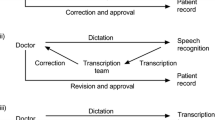Abstract
Background
Voice recognition (VR) dictation of radiology reports has become the mainstay of reporting in many institutions worldwide. Despite benefit, such software is not without limitations, and transcription errors have been widely reported.
Aim
Evaluate the frequency and nature of non-clinical transcription error using VR dictation software.
Methods
Retrospective audit of 378 finalised radiology reports. Errors were counted and categorised by significance, error type and sub-type. Data regarding imaging modality, report length and dictation time was collected.
Results
67 (17.72 %) reports contained ≥1 errors, with 7 (1.85 %) containing ‘significant’ and 9 (2.38 %) containing ‘very significant’ errors. A total of 90 errors were identified from the 378 reports analysed, with 74 (82.22 %) classified as ‘insignificant’, 7 (7.78 %) as ‘significant’, 9 (10 %) as ‘very significant’. 68 (75.56 %) errors were ‘spelling and grammar’, 20 (22.22 %) ‘missense’ and 2 (2.22 %) ‘nonsense’. ‘Punctuation’ error was most common sub-type, accounting for 27 errors (30 %). Complex imaging modalities had higher error rates per report and sentence. Computed tomography contained 0.040 errors per sentence compared to plain film with 0.030. Longer reports had a higher error rate, with reports >25 sentences containing an average of 1.23 errors per report compared to 0–5 sentences containing 0.09.
Conclusion
These findings highlight the limitations of VR dictation software. While most error was deemed insignificant, there were occurrences of error with potential to alter report interpretation and patient management. Longer reports and reports on more complex imaging had higher error rates and this should be taken into account by the reporting radiologist.
Similar content being viewed by others
References
Leeming BW, Porter D, Jackson JD, Bleich HL, Simon M (1981) Computerized radiologic reporting with voice data-entry. Radiology 138(3):585–588. doi:10.1148/radiology.138.3.7465833
Robbins AH, Horowitz DM, Srinivasan MK, Vincent ME, Shaffer K, Sadowsky NL, Sonnenfeld M (1987) Speech-controlled generation of radiology reports. Radiology 164(2):569–573. doi:10.1148/radiology.164.2.3602404
Mehta A, McLoud TC (2003) Voice recognition. J Thorac Imaging 18(3):178–182
Schwartz LH, Kijewski P, Hertogen H, Roossin PS, Castellino RA (1997) Voice recognition in radiology reporting. AJR Am J Roentgenol 169(1):27–29. doi:10.2214/ajr.169.1.9207496
Fox MA, Aschkenasi CJ, Kalyanpur A (2013) Voice recognition is here comma like it or not period. Indian J Radiol Imaging 23(3):191–194. doi:10.4103/0971-3026.120252
Olisemeke B, Chen YF, Hemming K, Girling A (2014) The effectiveness of service delivery initiatives at improving patients’ waiting times in clinical radiology departments: a systematic review. J Digit Imaging 27(6):751–778. doi:10.1007/s10278-014-9706-z
Kauppinen T, Koivikko MP, Ahovuo J (2008) Improvement of report workflow and productivity using speech recognition–a follow-up study. J Digit Imaging 21(4):378–382. doi:10.1007/s10278-008-9121-4
Krishnaraj A, Lee JK, Laws SA, Crawford TJ (2010) Voice recognition software: effect on radiology report turnaround time at an academic medical center. AJR Am J Roentgenol 195(1):194–197. doi:10.2214/ajr.09.3169
Kelley L (2011) Improving satisfaction performance through faster turnaround times. Radiol Manag 33(5):38–41
Sferrella SM (2003) Success with voice recognition. Radiol Manag 25(3):42–49
Pezzullo JA, Tung GA, Rogg JM, Davis LM, Brody JM, Mayo-Smith WW (2008) Voice recognition dictation: radiologist as transcriptionist. J Digit Imaging 21(4):384–389. doi:10.1007/s10278-007-9039-2
Kanal KM, Hangiandreou NJ, Sykes AM, Eklund HE, Araoz PA, Leon JA, Erickson BJ (2000) Evaluation of the accuracy of a continuous speech recognition software system in radiology. J Digit Imaging 13(2 Suppl 1):211–212
Rana DS, Hurst G, Shepstone L, Pilling J, Cockburn J, Crawford M (2005) Voice recognition for radiology reporting: is it good enough? Clin Radiol 60(11):1205–1212. doi:10.1016/j.crad.2005.07.002
McGurk S, Brauer K, Macfarlane TV, Duncan KA (2008) The effect of voice recognition software on comparative error rates in radiology reports. Br J Radiol 81(970):767–770. doi:10.1259/bjr/20698753
Quint LE, Quint DJ, Myles JD (2008) Frequency and spectrum of errors in final radiology reports generated with automatic speech recognition technology. J Am Coll Radiol JACR 5(12):1196–1199. doi:10.1016/j.jacr.2008.07.005
Chang CA, Strahan R, Jolley D (2011) Non-clinical errors using voice recognition dictation software for radiology reports: a retrospective audit. J Digit Imaging 24(4):724–728. doi:10.1007/s10278-010-9344-z
Strahan RH, Schneider-Kolsky ME (2010) Voice recognition versus transcriptionist: error rates and productivity in MRI reporting. J Med Imaging Radiat Oncol 54(5):411–414. doi:10.1111/j.1754-9485.2010.02193.x
Craciun H, Mankad K, Lynch J (2015) Risk management in radiology departments. World J Radiol 7(6):134–138. doi:10.4329/wjr.v7.i6.134
Williams DR, Kori SK, Williams B, Sackrison SJ, Kowalski HM, McLaughlin MG, Kuszyk BS (2013) Journal club: voice recognition dictation: analysis of report volume and use of the send-to-editor function. AJR Am J Roentgenol 201(5):1069–1074. doi:10.2214/ajr.10.6335
Hawkins CM, Hall S, Hardin J, Salisbury S, Towbin AJ (2012) Prepopulated radiology report templates: a prospective analysis of error rate and turnaround time. J Digit Imaging 25(4):504–511. doi:10.1007/s10278-012-9455-9
Hawkins CM, Hall S, Zhang B, Towbin AJ (2014) Creation and implementation of department-wide structured reports: an analysis of the impact on error rate in radiology reports. J Digit Imaging 27(5):581–587. doi:10.1007/s10278-014-9699-7
Paulett JM, Langlotz CP (2009) Improving language models for radiology speech recognition. J Biomed Inform 42(1):53–58. doi:10.1016/j.jbi.2008.08.001
Krupinski EA, Berbaum KS, Caldwell RT, Schartz KM, Kim J (2010) Long radiology workdays reduce detection and accommodation accuracy. J Am Coll Radiol JACR 7(9):698–704. doi:10.1016/j.jacr.2010.03.004
Krupinski E, Reiner BI (2012) Real-time occupational stress and fatigue measurement in medical imaging practice. J Digit Imaging 25(3):319–324. doi:10.1007/s10278-011-9439-1
Reiner BI, Krupinski E (2012) The insidious problem of fatigue in medical imaging practice. J Digit Imaging 25(1):3–6. doi:10.1007/s10278-011-9436-4
Reiner BI, Krupinski E (2012) Innovation strategies for combating occupational stress and fatigue in medical imaging. J Digit Imaging 25(4):445–448. doi:10.1007/s10278-011-9437-3
Reiner BI (2013) Expanding the functionality of speech recognition in radiology: creating a real-time methodology for measurement and analysis of occupational stress and fatigue. J Digit Imaging 26(1):5–9. doi:10.1007/s10278-012-9540-0
Author information
Authors and Affiliations
Corresponding author
Ethics declarations
Conflict of interest
None.
Rights and permissions
About this article
Cite this article
Motyer, R.E., Liddy, S., Torreggiani, W.C. et al. Frequency and analysis of non-clinical errors made in radiology reports using the National Integrated Medical Imaging System voice recognition dictation software. Ir J Med Sci 185, 921–927 (2016). https://doi.org/10.1007/s11845-016-1507-6
Received:
Accepted:
Published:
Issue Date:
DOI: https://doi.org/10.1007/s11845-016-1507-6




